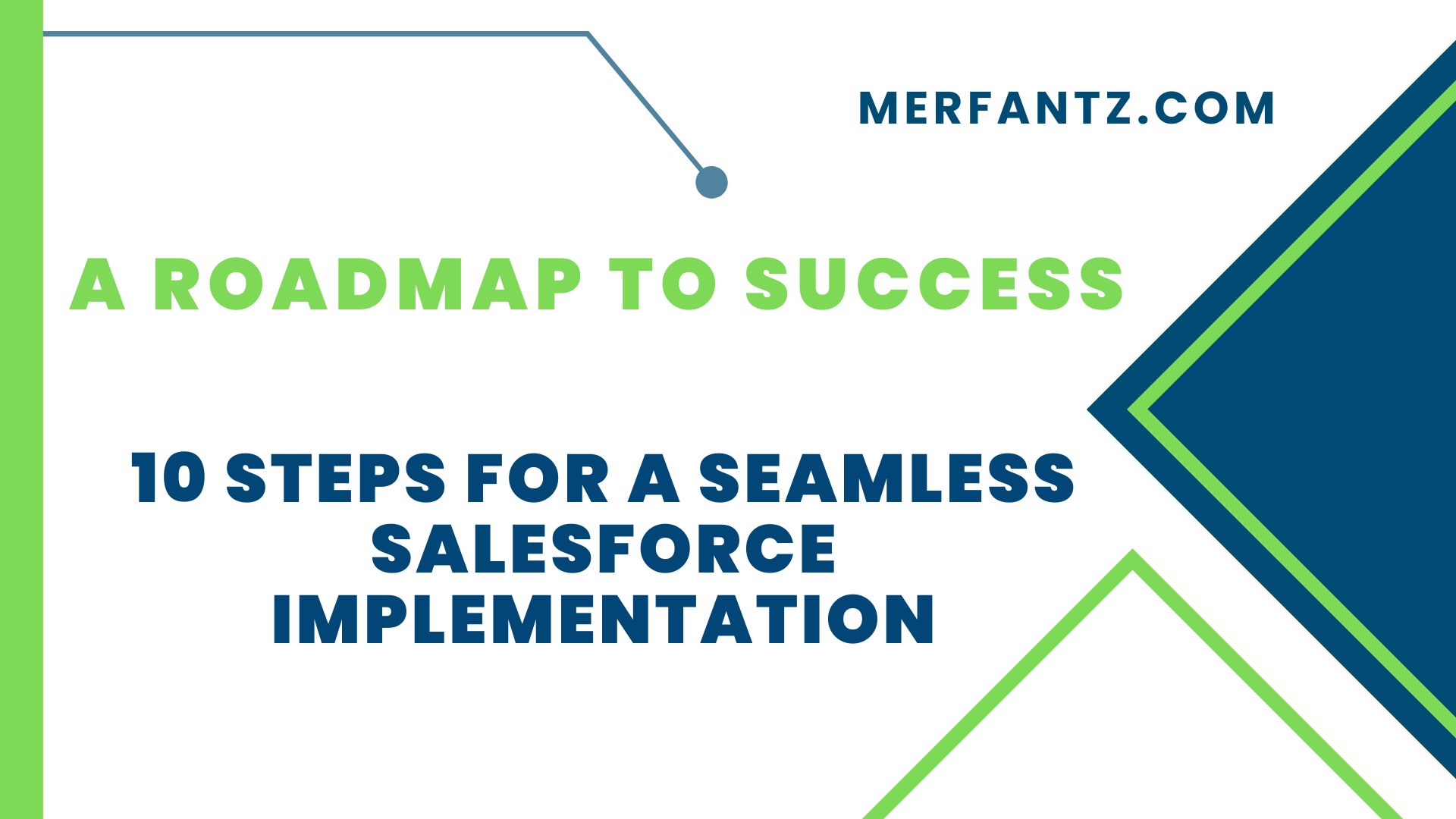Defining Your Salesforce Implementation Goals
Before embarking on a Salesforce implementation journey, it’s crucial to define your goals and objectives clearly. Take the time to assess your organization’s specific needs and challenges. Are you looking to streamline your sales processes, improve customer relationship management, or enhance marketing automation? By identifying your implementation goals, you can align Salesforce functionalities with your business objectives, ensuring a successful and impactful implementation.
During this phase, engage key stakeholders and decision-makers to gather insights and requirements. Understand the pain points of your sales, marketing, and customer support teams. This collaborative approach will help you create a comprehensive Salesforce roadmap tailored to your organization’s unique needs. By clearly defining your Salesforce implementation goals from the outset, you set a solid foundation for success.
Assessing Your Current Processes and Systems
Before integrating Salesforce into your existing infrastructure, it’s essential to evaluate your current processes and systems. Identify areas that require improvement or automation. Assess data quality, consistency, and accessibility. This evaluation will help you understand how Salesforce can best complement and optimize your current workflows. It will also highlight any gaps or challenges that need to be addressed during the implementation process.
In addition to evaluating processes, consider the technology landscape within your organization. Understand how Salesforce will integrate with your existing systems, such as CRM, ERP, or marketing automation tools. Assess the compatibility, data synchronization requirements, and potential for seamless data flow between systems. This evaluation ensures a smoother integration and allows for a comprehensive understanding of the impact Salesforce will have on your overall IT ecosystem.
Building a Strong Foundation: Data Cleansing and Migration
One of the critical aspects of a successful Salesforce implementation is ensuring the integrity and accuracy of your data. Start by conducting a thorough data audit to identify duplicate, incomplete, or outdated records. Implement data cleansing techniques to improve data quality, consistency, and reliability. This step sets the stage for leveraging Salesforce’s robust features and functionalities effectively.
Once your data is cleansed, develop a data migration strategy. Determine which data needs to be migrated to Salesforce and plan the migration process accordingly. Consider data mapping, transformation, and any necessary data formatting or validation requirements. Collaborate with your IT team and leverage tools and resources available to ensure a seamless and error-free data migration into Salesforce.
Customizing Salesforce to Your Business Needs
Salesforce offers a wealth of customization options to tailor the platform to your organization’s unique requirements. Start by defining custom fields, objects, and record types that align with your business processes. Leverage Salesforce’s point-and-click tools or engage the expertise of Salesforce developers to configure custom workflows, validation rules, and process automation. By customizing Salesforce, you can optimize the platform to mirror your organization’s specific workflows and enhance user adoption.
In addition to configuring Salesforce, consider integrating third-party applications or building custom applications using Salesforce AppExchange. Evaluate your business needs and identify areas where additional functionality is required. Explore available Salesforce integrations and extensions that can enhance your sales, marketing, or customer support processes. Customization empowers you to leverage Salesforce as a comprehensive solution that caters to your organization’s unique requirements.
Configuring Security and Access Controls
Ensuring the security of your data is paramount in any Salesforce implementation. Define a robust security model that aligns with your organization’s data access and privacy policies. Determine user roles, profiles, and permission sets to control data visibility and restrict access to sensitive information. Implement strong password policies, two-factor authentication, and IP restrictions to enhance data protection. By configuring comprehensive security measures, you can safeguard your data and maintain the trust of your users.
Consider the different levels of access control within Salesforce, such as organization-wide sharing settings, role hierarchies, and record-level security. Assess the specific needs of your departments and user groups to grant appropriate levels of access. Regularly review and update security settings as your organization evolves. By prioritizing security and access controls, you can maintain data confidentiality, integrity, and compliance with industry regulations.
Training and Onboarding Your Team
Successful Salesforce implementation relies on effective user adoption and utilization of the platform. Provide comprehensive training and onboarding programs to ensure your team understands Salesforce’s features, functionalities, and benefits. Develop training materials, conduct workshops, and offer hands-on guidance to empower your employees to leverage Salesforce effectively. Tailor the training sessions to different user groups and their specific roles within the organization.
Encourage continuous learning by providing access to Salesforce resources, online documentation, and training videos. Foster a culture of knowledge sharing and encourage employees to seek support from Salesforce’s online community or internal subject matter experts. By investing in training and onboarding, you equip your team with the skills and confidence needed to utilize Salesforce to its full potential, driving productivity and efficiency.
Integrating Salesforce with Existing Systems
To maximize the benefits of Salesforce, it’s crucial to integrate it seamlessly with your existing systems. Identify the key systems and applications that interact with customer data or contribute to your business processes. Evaluate the available integration options, such as APIs, middleware, or pre-built connectors. Collaborate with your IT team or engage Salesforce integration specialists to establish secure and efficient data synchronization between Salesforce and your other systems.
During the integration process, consider the flow of data and information between systems. Determine which data needs to be shared, synchronized, or consolidated across platforms. Ensure that data integrity is maintained and that any updates or changes in one system are reflected in all relevant systems. By integrating Salesforce with your existing systems, you can create a unified ecosystem that facilitates seamless data exchange and enhances overall operational efficiency.
Testing and Quality Assurance
Thorough testing and quality assurance are critical to ensure the stability and reliability of your Salesforce implementation. Develop a comprehensive testing plan that includes functional testing, user acceptance testing, and performance testing. Test different scenarios, workflows, and configurations to identify and address any issues or bugs. Engage a dedicated testing team or leverage Salesforce’s testing tools to conduct rigorous testing at each stage of the implementation.
Prioritize data integrity during testing by verifying the accuracy and consistency of data across various Salesforce modules and integrated systems. Test data migration processes to ensure data mapping, transformation, and validation are functioning correctly. Conduct load testing to assess the system’s performance under various user loads. By investing in thorough testing and quality assurance, you can identify and rectify any issues before the Salesforce implementation goes live, ensuring a smooth user experience.
Go-Live and Deployment Strategy
As you approach the go-live stage of your Salesforce implementation, it’s crucial to develop a comprehensive deployment strategy. Plan the timing, sequence, and communication around the go-live to minimize disruptions to your operations. Coordinate with key stakeholders, IT teams, and end-users to ensure a smooth transition. Conduct thorough user acceptance testing to address any last-minute issues and provide necessary training or support to users during this critical phase.
Consider a phased rollout strategy where Salesforce is implemented in stages or deployed to specific departments or user groups. This approach allows for easier management of change and provides opportunities to learn from each phase before expanding further. Monitor system performance, user feedback, and adoption rates closely during the go-live phase to make any necessary adjustments and ensure a successful launch of Salesforce across your organization.
Ongoing Support and Optimization Techniques
Even after the initial implementation, ongoing support and optimization are essential to maintain the effectiveness of Salesforce. Establish a support system that includes a dedicated Salesforce administrator or a support team to address user inquiries, troubleshoot issues, and provide guidance. Stay updated with Salesforce releases, new features, and best practices to leverage the latest innovations and continually enhance your Salesforce implementation.
Regularly assess and optimize your Salesforce configuration and processes to align with evolving business needs. Collaborate with stakeholders to gather feedback and identify areas for improvement. Leverage Salesforce reporting and analytics tools to gain insights into system usage, performance, and user adoption. This data-driven approach allows you to make informed decisions and drive continuous improvement in leveraging Salesforce to achieve your business goals.
FAQs (Frequently Asked Questions)
Why is defining Salesforce implementation goals important?
Defining Salesforce implementation goals is crucial as it helps align the platform with your business objectives. By clearly identifying your goals, you can tailor Salesforce functionalities to address specific needs, whether it’s streamlining sales processes, improving customer relationship management, or enhancing marketing automation. This alignment ensures a successful and impactful implementation that drives business growth.
How do I assess my current processes and systems before implementing Salesforce?
Assessing your current processes and systems is essential to understand areas that require improvement or automation. Conduct a thorough evaluation of data quality, consistency, and accessibility. Additionally, consider the technology landscape within your organization and how Salesforce will integrate with existing systems, such as CRM, ERP, or marketing automation tools. This evaluation provides insights into how Salesforce can complement and optimize your workflows.
Why is data cleansing and migration important in Salesforce implementation?
Data cleansing and migration are vital steps to ensure data integrity and accuracy in Salesforce. Conducting a data audit helps identify duplicate, incomplete, or outdated records, while data cleansing techniques improve data quality. Proper data migration planning ensures a seamless transfer of data into Salesforce, including data mapping, transformation, and validation. By addressing data-related challenges, you establish a strong foundation for leveraging Salesforce effectively.
How can I customize Salesforce to meet my business needs?
Salesforce offers extensive customization options to tailor the platform to your organization’s requirements. Start by defining custom fields, objects, and record types that align with your business processes. Leverage point-and-click tools or engage Salesforce developers to configure custom workflows, validation rules, and process automation. Integration with third-party applications or building custom applications using Salesforce AppExchange can further enhance functionality. Customization allows you to optimize Salesforce to mirror your organization’s unique workflows and enhance user adoption.
How do you implement a successful Salesforce?
Implementing a successful Salesforce involves defining clear goals, assessing current processes, customizing the platform to business needs, ensuring data integrity, providing comprehensive training, and ongoing support and optimization.
How do I prepare for Salesforce implementation?
To prepare for Salesforce implementation, assess your current processes and systems, define implementation goals, ensure data quality, plan customization, configure security and access controls, provide training, and develop a deployment strategy.
What is the #1 key to success in any Salesforce project?
The #1 key to success in any Salesforce project is effective user adoption. Ensuring that your team embraces and effectively utilizes the platform through training, onboarding, and ongoing support is crucial for a successful implementation.
What is the timeline for Salesforce implementation?
The timeline for Salesforce implementation varies based on factors such as the complexity of your business processes, the scale of deployment, data migration requirements, and customization needs. It is best to work with a Salesforce implementation partner or consultant to determine a realistic timeline for your specific project.
Conclusion:
A successful Salesforce implementation requires careful planning, execution, and ongoing support. By following the 10 steps outlined in this roadmap, from defining implementation goals to ongoing optimization, you can ensure a seamless Salesforce implementation that aligns with your organization’s unique needs. Remember to engage key stakeholders, invest in user training, and prioritize data integrity and security. With the right strategy and dedication, Salesforce can become a powerful tool to drive business growth, streamline processes, and enhance customer experiences.
Author Bio
Co-Founder & CMO at Merfantz Technologies Pvt Ltd | Marketing Manager for FieldAx Field Service Software | Salesforce All-Star Ranger and Community Contributor | Salesforce Content Creation for Knowledge Sharing






